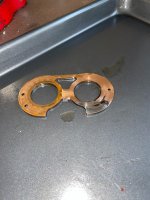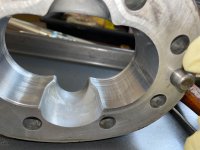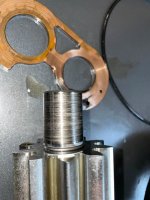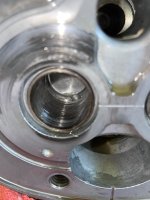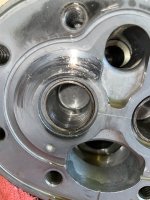hayden
Elite Member
- Joined
- Sep 23, 2000
- Messages
- 2,515
- Location
- VT
- Tractor
- Kubota L5740 cab + FEL, KX121, KX080, Deere 6120M
I'm cross posting this in the Hydraulics forum since it's now clearly a hydraulic problem. I'd love to get a read from experienced hydraulic repair people about what might have caused this damage.
This is a 3PH PTO driven hydraulic pump that is part of a power pack for powering a hydraulic snow blower. It's used and new to me, so I have no history on the machine. But it wasn't developing power as expected so I started looking into the system pressure which turned out to be 1000 psi rather than 3000 psi. I rearranged my test gear to test the pump, and here's what I found.
I hooked up my flow meter, gauge, and variable restrictor immediately at the outlet of the pump. With engine at idle, no load but the blower rotating, I get 10 gpm and barely detectable pressure. That's normal. But when I apply load to the pump by restricting flow, it couldn't develop more than 500 psi, even when completely dead headed. This is down from 1000 psi just yesterday.
So I pulled the pump apart and indeed it's trashed. Take a look at the attached pictures. I think the housing it too damaged to even attempt a rebuild, so I'll be getting a new pump. Now I just need to figure out what it is. I did finally find some numbers on it and an embossed "Eaton", so with that I suspect I can figure it out.
If anyone has any pump rebuild experience, I'd be real interested in a read on what might have caused this damage. Because this power pack has no active cooling, and relies solely on ambient temp and operator attention to duty cycle to prevent overheating, I think previous overheating is a distinct possibility. So I'm particularly interested in whether this could have been caused by overheating. I guess the other possibilities are cavitation or contamination.
Thanks in advance.
This is a 3PH PTO driven hydraulic pump that is part of a power pack for powering a hydraulic snow blower. It's used and new to me, so I have no history on the machine. But it wasn't developing power as expected so I started looking into the system pressure which turned out to be 1000 psi rather than 3000 psi. I rearranged my test gear to test the pump, and here's what I found.
I hooked up my flow meter, gauge, and variable restrictor immediately at the outlet of the pump. With engine at idle, no load but the blower rotating, I get 10 gpm and barely detectable pressure. That's normal. But when I apply load to the pump by restricting flow, it couldn't develop more than 500 psi, even when completely dead headed. This is down from 1000 psi just yesterday.
So I pulled the pump apart and indeed it's trashed. Take a look at the attached pictures. I think the housing it too damaged to even attempt a rebuild, so I'll be getting a new pump. Now I just need to figure out what it is. I did finally find some numbers on it and an embossed "Eaton", so with that I suspect I can figure it out.
If anyone has any pump rebuild experience, I'd be real interested in a read on what might have caused this damage. Because this power pack has no active cooling, and relies solely on ambient temp and operator attention to duty cycle to prevent overheating, I think previous overheating is a distinct possibility. So I'm particularly interested in whether this could have been caused by overheating. I guess the other possibilities are cavitation or contamination.
Thanks in advance.

